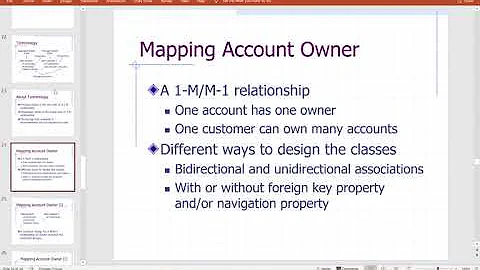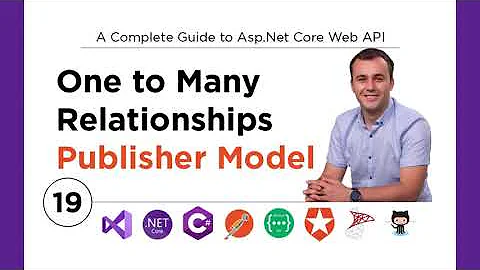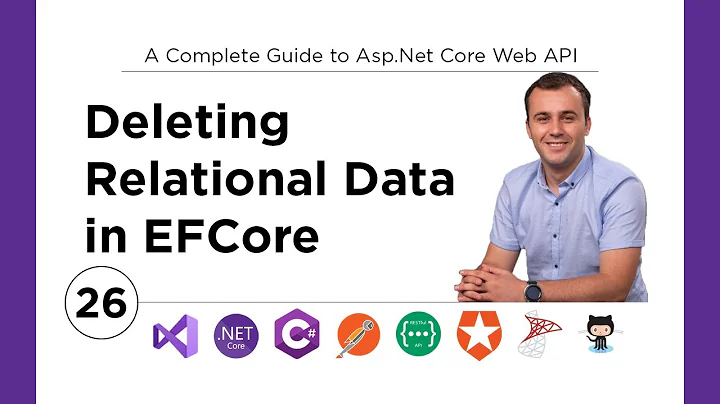Entity Framework Core: Update relation with Id only without extra call
Solution 1
So the question is if we have
Childinstance and knowSchool.Idis there a way to update this relation without extra call to database to obtainSchoolinstance.
Yes, it's possible. You can create a fake stub School entity instance with Id only, Attach it to the DbContext (this way telling the EF that it is existing), Attach the Child instance for the same reason, and then add the Child to the parent collection and call SaveChanges:
Child child = ...;
var schoolId = ...;
var school = new School { Id = schoolId };
context.Attach(school);
context.Attach(child);
school.Childrens.Add(child);
context.SaveChanges();
Update: Actually there is another cleaner way, since even if the entity has no navigation or FK property, EF Core allows you to access/modify the so called Shadow Properties
Shadow properties are properties that do not exist in your entity class. The value and state of these properties is maintained purely in the Change Tracker.
as soon as you know the name. Which in your case, without configuration would be by convention "SchoolId".
So no fake School entity instance is needed, just make sure the Child is attached and then simply set the shadow property through ChangeTracker API:
context.Attach(child);
context.Entry(child).Property("SchoolId").CurrentValue = schoolId;
context.SaveChanges();
Solution 2
Based on the updated question
No, there isn't ANY way you could do that by using ORM and strong typing that the ORM offers you, w/o
- Two-Way Navigation Property
- At least a ForeignKey/Principal property(
SchoolIdonChild) - Having a shadow foreign key to the parent
-
performing a raw query (which beats the idea of having ORM for strong typing) and being DB agnostic at the same time
// Bad!! Database specific dialect, no strong typing ctx.Database.ExecuteSqlCommandAsync("UPDATE Childs SET schoolId = {0}", schoolId);
When you choose to use an ORM you have to accept certain technical limitations of the ORM framework in question.
If you want to follow Domain Driven Design (DDD) and remove all db specific fields form your entities, it won't be easy to use your domain models as entities.
DDD and ORM don't have very good synergies, there are way better approaches for this, but require a different architectural approach (namely: CQRS+ES (Command Query Responsibility Segregation with Event Sourcing).
This works much better with DDD, since the Events from the EventSourcing are just simple (and immutable) message classes which can be stored as serialized JSON in the database and replayed to reconstruct the domain entity's state. But that's a different story and one could write whole books about this topic.
Old Answer
The above scenario is only possible in a single DB operation, if your Child objects a navigation property/"back reference" to the parent.
class School
{
public ICollection<Child> Childrens {get; set;}
...
}
and
class Child
{
public int Id {get; set;}
// this is required if you want do it in a single operation
public int SchoolId { get; set; }
// this one is optional
public School { get; set; }
...
}
Then you can do something like:
ctx.Childs.Add(new Child { Id = 7352, SchoolId = 5, ... });
Of course you first have to know the school Id and know it's valid, otherwise the operation will throw an exception if SchoolId is an invalid value, so I wouldn't recommend this approach.
If you only have the childId and not adding a whole new child you'll still have to get the child first.
// childId = 7352
var child = ctx.Childs.FirstOrDefault(c => c.Id == childId);
// or use ctx.Childs.Find(childId); if there is a chance that
// some other operation already loaded this child and it's tracked
// schoolId = 5 for example
child.SchoolId = schoolId;
ctx.SaveChanges();
Related videos on Youtube
silent_coder
Updated on September 15, 2022Comments
-
silent_coder almost 2 years
I'm trying to figure out how to deal with 'Single navigation property case' described in this doc:
Let's say we have 2 models.
class School { public ICollection<Child> Childrens {get; set;} ... }and
class Child { public int Id {get; set;} ... }So it's many-to-one relationship created by convention, without explicit foreign key in a
Child.So the question is if we have
Childinstance and knowSchool.Idis there a way to update this relation without extra call to database to obtainSchoolinstance.-
 Tseng about 7 yearsUnless your
Tseng about 7 yearsUnless yourChildhas a navigation property/parent id to the parent, you can't do that (that's: w/o a raw query). ORM is about Object Relationships. But w/o loading the parent first, you don't even know if7352is a valid parent id, so you'll have to do it at one point anyways or get an hard to parse exception from the database provider when doingSaveChanges()
-
-
 Ivan Stoev about 7 years
Ivan Stoev about 7 yearsctx.Childs.Addwill ignore theIdand will try to add newChildrecord. -
 Tseng about 7 yearsYes, it's for adding a new Child. For changing the school, there is no a way around at least retrieving the
Tseng about 7 yearsYes, it's for adding a new Child. For changing the school, there is no a way around at least retrieving theChildobject once (with a raw query being the exception, but that beats the purpose of having ORM in the first place). But he can save theSchoolquery in any case with a parent leading navigation property or foreign key (SchoolIdhere) -
silent_coder about 7 yearsdocs.microsoft.com/en-us/ef/core/modeling/relationships in this doc there is a case described - called 'single navigation property', so in this case there is no explicit
BlogIdinsidePost, however I'm pretty confident that it's created in a table. So my question was about this case. I thought that there is a way exists, which will change only this "implicit"BlogIdwhen adding post to aBlog.Postscollection. -
E-Bat about 7 years@silent_coder, check again the sample, there is the property BlogId inside Post as well.
-
silent_coder about 7 years@E-Bat No it's not. Scroll to proper section.
-
 Tseng about 7 yearsNo, there isn't any other way. There used to be some (3rd party) extension methods for EF 6 which could perform updates w/o reading, dunno if they are available for EntityFramework.Extended where you could do something like
Tseng about 7 yearsNo, there isn't any other way. There used to be some (3rd party) extension methods for EF 6 which could perform updates w/o reading, dunno if they are available for EntityFramework.Extended where you could do something likectx.Childs.Where(c => c.Id == childId).Update(c => new Child { SchoolId = 5})), but dunno if they are ported to EF Core, when executed it would generate an "UPDATE. ..." query w/o first loading any entity. But this project doesn't seem to have received any updates in the past 2-3 years, so likely dead -
E-Bat about 7 years@silent_coder, you refer to the section of shadow property. I would stay away from that because shadow properties are attached to the state of the DbContext, this means they are useless in disconnected scenarios where you send your entity over the wire.
-
 Tseng about 7 years
Tseng about 7 yearsBlogIdwithinPostclass isn't a shadow property. A shadow property is one that's not defined on the poco class but exists in the database. Anyways... You shouldn't EVER send your EF Entities over the wire (i.e. as api response). Always use ViewModel (or binding model what ever you want to call it for Rest API). Exposing your EF Core Entity model to the WebAPI will kick you in the ass very hard at the same moment, when the database has a slight change and then your api breaks because of additional fields -
E-Bat about 7 years@Tseng, He is referring to the section where the FK is mapped as shadow property. I know that from an api one should not be returning full entities... But you cannot assume that the domain model will only be consumed from an api, it could be a desktop client as well and there it make sense passing entities from one layer to another, so no shadow porperties for FK is my recomendation.
-
 Tseng about 7 years@E-Bat: Well the actual recommendation is not to use the entities for any outside of the
Tseng about 7 years@E-Bat: Well the actual recommendation is not to use the entities for any outside of theDbContext. Not for domain models, not for webapi, not to be used as Dto and always have separate classes for each of these types. Everything else will end up being messy or Db specific stuff (Id fields) leaking into other layers of your application -
E-Bat about 7 years@Tseng, not 100% agree, but that topic can be the subject of a very long discussion :)
-
 Tseng about 7 yearsDidn't thought about doing it that way. Personally I think it's not very reliable though. Won't it create a new school in case
Tseng about 7 yearsDidn't thought about doing it that way. Personally I think it's not very reliable though. Won't it create a new school in caseschoolIddoesn't exist? And also create all kind of other weird behavior when it's queried later one, because the references for the school will be taken from the tracked cache? -
 Ivan Stoev about 7 years@Tseng Indeed. The caller must be absolutely sure both entities exist. And the
Ivan Stoev about 7 years@Tseng Indeed. The caller must be absolutely sure both entities exist. And theDbContextshould be short lived instance just for this operation. What about reliability, if one of the entities does not exist, the caller will getDbUpdateExceptionand no change will be made to the database. Actually the above sequence of operations generates a singleUPDATEcommand :) -
Muflix about 5 yearswhat is navigation relation setting for Child.SchoolId ? When i create school and add child and call SaveChanges(), foreign key constraint stop the call with exception, that schoolId is null.
-
Rei Miyasaka over 2 yearsAlso, you now have a random string in your code for which you won't get any notification if your db field name changes.







